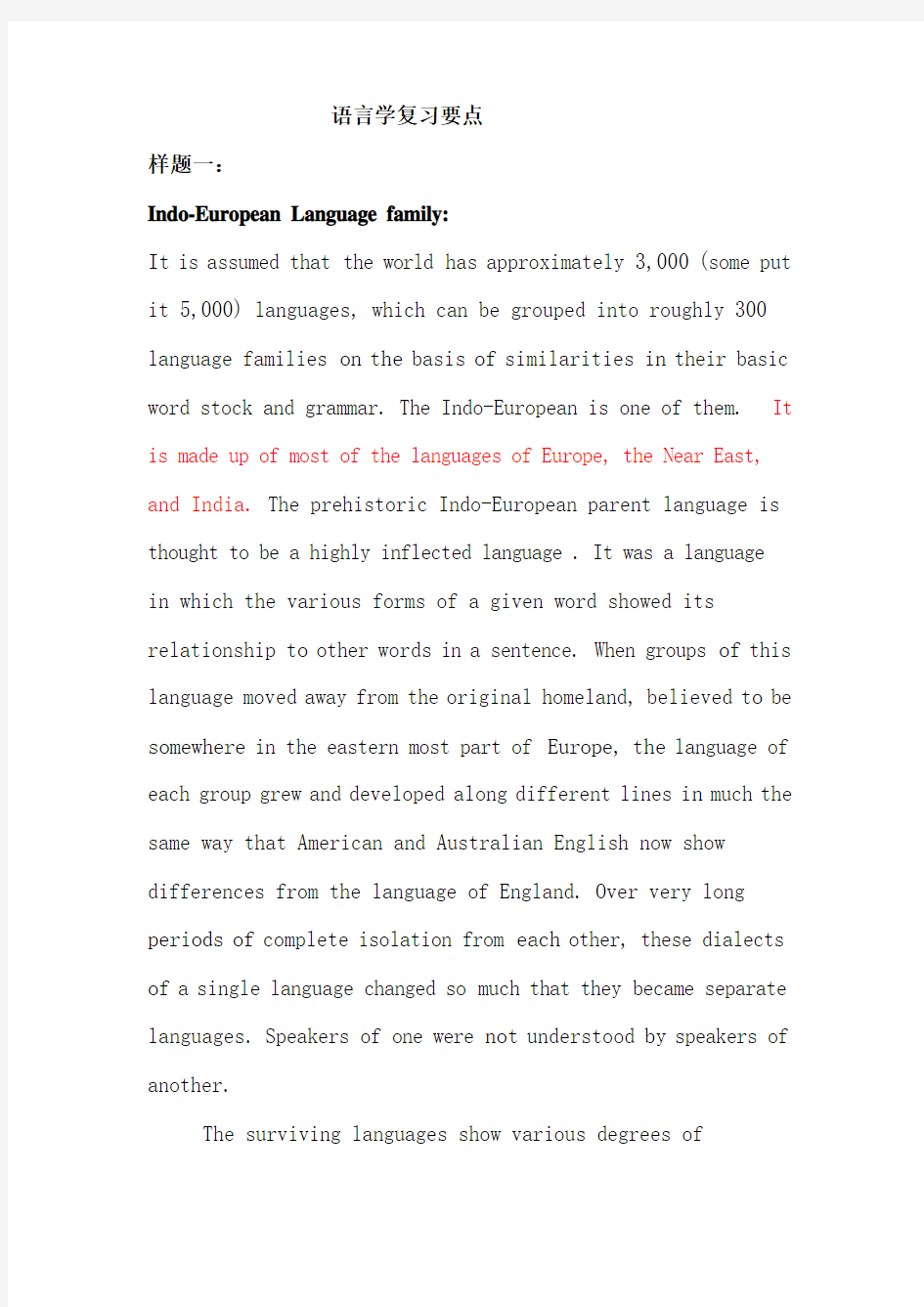语言学复习要点

- 1、下载文档前请自行甄别文档内容的完整性,平台不提供额外的编辑、内容补充、找答案等附加服务。
- 2、"仅部分预览"的文档,不可在线预览部分如存在完整性等问题,可反馈申请退款(可完整预览的文档不适用该条件!)。
- 3、如文档侵犯您的权益,请联系客服反馈,我们会尽快为您处理(人工客服工作时间:9:00-18:30)。
语言学复习要点
样题一:
Indo-European Language family:
It is assumed that the world has approximately 3,000 (some put it 5,000) languages, which can be grouped into roughly 300 language families on the basis of similarities in their basic word stock and grammar. The Indo-European is one of them. It is made up of most of the languages of Europe, the Near East, and India. The prehistoric Indo-European parent language is thought to be a highly inflected language . It was a language in which the various forms of a given word showed its relationship to other words in a sentence. When groups of this language moved away from the original homeland, believed to be somewhere in the eastern most part of Europe, the language of each group grew and developed along different lines in much the same way that American and Australian English now show differences from the language of England. Over very long periods of complete isolation from each other, these dialects of a single language changed so much that they became separate languages. Speakers of one were not understood by speakers of another.
The surviving languages show various degrees of
similarity to one another. The similarity bear a more or less direct relationship to their geographical distribution. They accordingly fall into eight principal groups, which can be grouped into an Eastern set: Balto-Slavic , Indo-Iranian, Armenian and Albanian; a Western set: Celtic, Italic, Hellenic, Germanic.
In the Eastern set, Armenian and Albanian are each the only modern language respectively. The Balto-Slavic comprises such modern languages as Prussian, Lithuanian, Polish, Czech, Bulgarian, Slovenian and Russian. In the Indo-Iranian we have Persian, Bengali,Hindi,Romany, the last three of which are derived from the dead language Sanskrit.
In the Western set,Greek is the modern language derived from Hellenic. In the Celtic, we find Scottish, Irish, Welsh, Breton, etc. The five Romance languages, namely, Portuguese, Spanish, French, Italian, Roumanian all belong to the Italic through an intermediate language Latin. The Germanic family consists of the four Northern European Languages, which are generally known as Scandinavian languages. Then there is German, Dutch, Flemish and English.
All these languages have some influence on English to a greater or lesser extent because each has lent words into the
English vocabulary. Some of them have played a considerable role in the course of the development of the English vocabulary. Sense relations between words:
Synonymy: the sameness or close similarity of meaning. 同义现象是指意义的相同或极为相近。
Polysemy: the same one word may have more than one meaning. This is what we call polysemy. 多义现象指同一个词可能有多个意义。Homonymy:refers to the phenomenon that words having different meanings have the same form, i.e., different words are identical in sound or spelling, or in both.
同音/同形异义是指某些词的意义不同,但是具有相同形式的现象,即不同的词在发音或拼写上一样,或发音和拼写都一样。Homophones:words which sound alike but are written differently and often have different meanings. 同音异义词是指发音相同但拼写不同,通常意义也不同的词。
Homographs:words which are written in the same way but which are pronounced differently and have different meanings. 同形异义词是指词形相同但发音、词义各异的词。
Complete homonyms:words which are identical in both sound and spelling, but different in meanings.
完全同音同形异义词是指发音和拼写都相同,但意义不同的词。Hyponymy: refers to the sense relation between a more general, more
